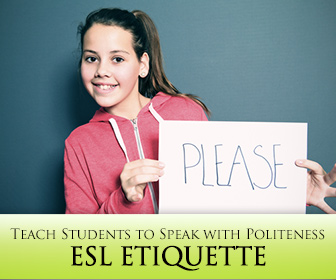More than Words: What Your Students Need to Know About Body Language


So many things vary from one country to another and one people group to another, and what it means to be polite in any given culture is no exception. Every culture has certain expectations when it comes to how and when to speak, and being polite in difficult, frustrating, depressing or emotional situations can be a challenge for your students as it is to native English speakers. To familiarize your students with what it means to be polite in the U.S., try this lesson plan on teaching students to speak with politeness.

Start your lesson on politeness by posing a tough question to your students. How would they confront a teacher who they thought was being unfair in their grading? How would they tell a friend that his girlfriend was cheating on him? How would they tell a parent that they were quitting school? Any of these questions or others like them will get your students thinking about how to talk to someone about something uncomfortable. After your students think about the situation and perhaps discuss it with a partner, challenge them to come up with advice for someone else who might be facing the tough situation.

One of the best ways for your students to understand each other as well as their host culture is to talk about the importance of politeness in their home cultures. Put your students into groups of four or five, preferably students from various cultures, and then have them discuss the following questions.
When students discuss these questions, they are bound to hit on some interesting topics. It is important to show politeness to your elders? Your superiors? People with power or money? Different cultures will have different values, and values dictate what type of behavior is expected. All these cultural values will come out in your students’ discussions.
Now that your students have discussed situations in which they should show politeness in their home cultures, have your class work together to create master list. On your list, include as many situations as you and your students can conceive in which it is important to show politeness.

Once you have a list of situations your students think require politeness, walk them through these rules for polite conversation in the U.S.
Impolite speech starts with a negative attitude toward a situation or a person. The first step in acting politely is noticing when that bad attitude is rising up within you.
A person can learn a lot about how someone else feels by looking at their facial expressions and listening to their words and tone of voice. Help your students understand what these signals mean in the U.S. If their listener’s face is tense, their eyebrows are drawn together, or their lips are pressed together tightly, that person is upset. Other body language can indicate boredom, confusion and disbelief.
Using a loud voice or forceful speech is considered impolite among English speakers in the U.S., and using an inappropriate voice volume may make a situation worse rather than better. Help your students understand the proper volume and tone of voice at which to speak.
While it is okay to speak with your hands in the U.S., using forceful gestures, pointing and hitting are all considered aggressive behavior in a conversation. Help your students understand just how much is too much when it comes to using their bodies while they speak. This is also a good time to address personal space. Americans generally leave about two feet between themselves and the person with whom they are speaking, and they do this without even realizing. Standing too close to a person or too far from them may send the wrong message in a conversation.
Answering someone with sarcasm, insults, or a lack of seriousness is another way to send the wrong message to someone with whom you are speaking. Though these responses are sometimes acceptable in specific situations, your students would do better to follow this rule: if in doubt, leave them out. Insulting a conversation partner may do so much damage that the person is unwilling to continue any conversation. Tell your ESL students that avoiding these responses is the safest strategy.
Native speakers sometimes struggle with this polite conversation guideline as much as nonnative speakers do. Our grandmothers told us to think before we speak for a reason. Reacting and responding are not the same thing in a conversation, and sometimes saying the first thing that comes to mind can be very detrimental (see guideline #5). Taking a moment to think about what you want to say, making sure it is appropriate and kind, can make the difference between a relationship deepening and relationship destroying conversation.
Once you have discussed these guidelines with your students, have them think back to the difficult situation they discussed at the beginning of the lesson. Did their advice follow these guidelines? If so, great! If not, you may want to have your students come up with some different advice.

This summary activity will encourage creativity and humor in your students. Have groups of four or five work together to write a skit about a situation in which a person can be impolite. Your students should choose a situation from the master list you compiled as a class. Each group will write and perform two skits about this situation. In the first skit, they will show how NOT to act in their situation. In this version, they should not follow the polite speech guidelines. They should also write a second skit about the same situation. In this skit, students should show how to speak politely following the six polite conversation guidelines. Each group should perform both skits for their class, and the viewers are sure to have as much fun as the performers when they watch their classmates being intentionally rude in a conversation. Not only that, but acting in and watching skits will help your students remember what it means to speak politely in the U.S.
If so, how do you handle the situation?